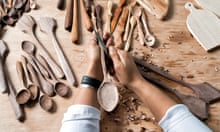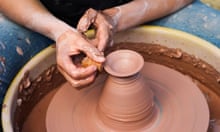It is a craft that requires imagination, concentration and precision. And, when you are about to plunge a chisel into a wonderfully smooth piece of lime wood, a degree of boldness.
Owen Morse-Brown, whose workshop is tucked away on a light industrial estate in Wiltshire, is one of the last British artisans blessed with the skills to create wooden hat blocks – moulds for headwear ranging from the sort of creations Ascot racegoers sport to trilbies, fedoras, bowlers, porkpies and Bretons.
Morse-Brown’s craft is one of 17 that has been placed on a “red list” judged by the Heritage Craft Association to be critically endangered. The association claims that crafts such as shaping clay pipes and carving clogs are at serious risk of no longer being practised and is calling on the government to take action.
It says that unless something is done many crafts will follow the handmaking of cricket balls and lacrosse sticks into its “extinct” category.
Greta Bertram, who led the red list research on behalf of the Heritage Crafts Association, said: “We would like to see the government recognise the importance of traditional craft skills as part of our cultural heritage, and take action to ensure they are passed on to the next generation.
“Craft skills today are in the same position that historic buildings were a hundred years ago. We recognise the importance of old buildings as part of our heritage, and it’s time for us to join the rest of the world and recognise that these living cultural traditions are just as important and need safeguarding too.”
Morse-Brown agreed. “Crafting and traditional skills are hugely important,” he said. “Making things and passing on knowledge through the generations is part of what makes us human.”
Up until the 1940s and 50s, hats were commonly made on wooden moulds. “Everybody wore a hat,” said Morse-Brown. “So millions of blocks were needed for every style, every size. But things changed.”
Hats tend to be made on metal moulds that can be heated. “It’s a lot quicker and less manual like almost everything,” Morse-Brown said. According to the Heritage Craft Association, cheap Chinese imports are also to blame and its red list says there are only between one and five hat block makers left in the UK.
Owen took over the business from his father, Guy Morse-Brown, a decade ago. Until then he had specialised in making viols and other early stringed instruments but his father tutored him in the very particular requirements of hat block making.
The type of wood is important. For most blocks French lime timber is used because it is soft enough to take a pin when the hat is being made. An African hardwood is used for larger blocks as it is lighter to handle. Wood arrives in planks and is sawed and glued to create square blocks. Each piece is then chiselled, gouged and sanded into the required shape by hand.
The Morse-Brown blocks are used by high-end milliners and by film and theatre costume makers. But most – perhaps about 75% – are now bought by hobbyists who create their own hats. “Most are Ascot or wedding hats, but over the last few years there has been an increase in people wanting to make men’s hats, which is fantastic,” said Morse-Brown.
He can sometimes be spotted strolling around his hometown of Devizes in a natty handmade hat, his favourite a brown, long-haired bowler decorated with feathers.
The Morse-Brown catalogue boasts about 500 styles and shapes and the blocks range from about £50 to £350. A week rarely goes by without a customer ordering a new style of hat block.Block of the month on the Morse Brown website is currently FB57 – which allows the creation of a headband-style “hat”.
Morse-Brown talks passionately about the art of making sure the lines and proportions are correct and how the play of light on a block can help the craftsperson make sure new design will work. “The skill base is very particular,” he said. “You need to know about hat making or you will make shapes that don’t work.”
While hat block making is on the red list, the Morse-Brown business is doing well. It moved to bigger premises in 2014 and a couple of part-time workers are employed.
But will the craft be passed down to a new generation? “I’ve got three children and the middle one is pretty keen on doing it,” said Morse-Brown. “We’ll see how it goes.”
Dying arts
This is the list of crafts classified as “critically endangered” by Heritage Craft Association – ie at serious risk of no longer being practised. They include crafts with a shrinking base of craftspeople, with limited training opportunities, with low financial viability, and crafts where there is no mechanism to pass on the skills and knowledge.
- Clay pipe making
- Clog making (hand-carved soles)
- Coachbuilding and wagon making (horse drawn vehicles)
- Collar making (for horses traditionally with a leather outer and rye straw filling)
- Devon maund making (a basket made of wooden splints)
- Fan making
- Fore edge painting (the application of an image to the edges of the pages of a book)
- Hat block making
- Metal thread making
- Paper marbling (the application of an aqueous surface design on to paper, which can produce patterns similar to smooth marble or other kinds of stone)
- Parchment and vellum making
- Piano making
- Plane making
- Saw making
- Spade making (forged heads)
- Swill basket making (from woven strips of cleft oak)
- Tanning oak bark (the process of using oak bark tanning to convert raw hide/skin into leather)









Comments (…)
Sign in or create your Guardian account to join the discussion